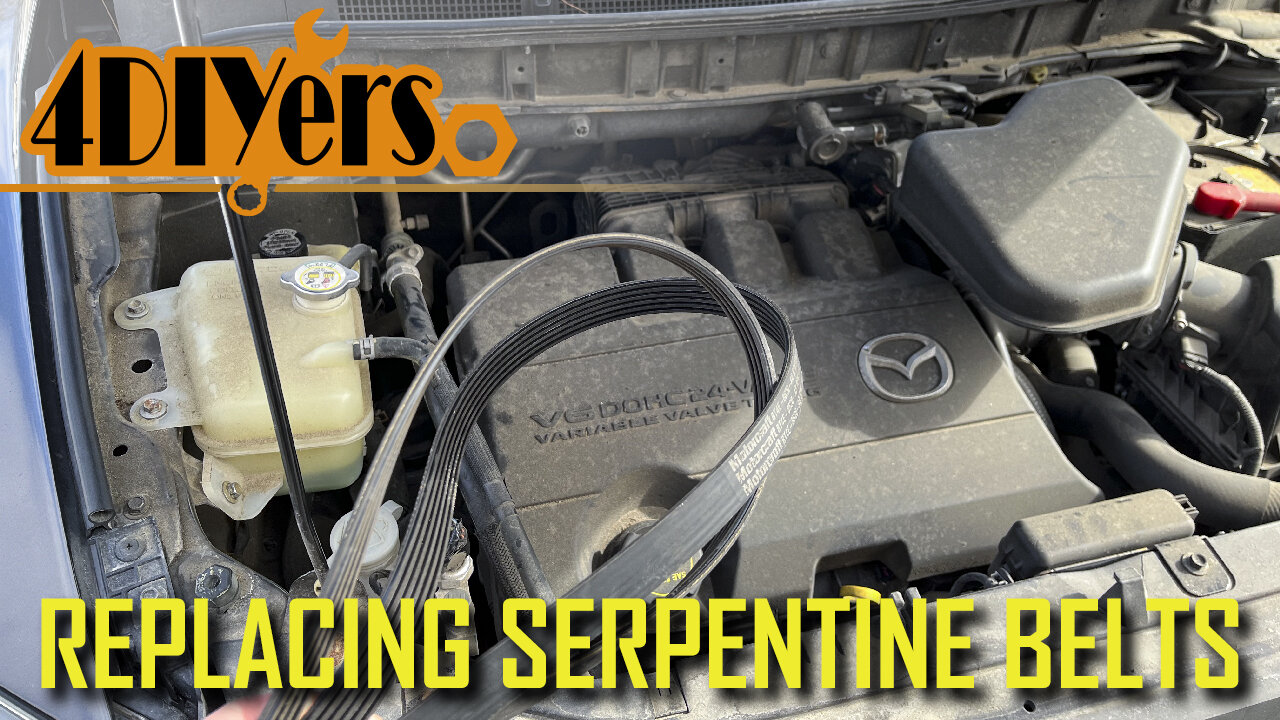Premium Only Content

How to Change the Serpentine Belts on a Mazda CX9 3.7L V6
How to how to change both serpentine belts on a first-generation Mazda CX9 equipped with the 3.7L V6. This engine is also found in other Ford and Lincoln models from the same generation. This is a 2015 model. A squeaking is an indication of the belt slipping, therefore it’s stretched. I would recommend replacing both and also checking the tensioner to ensure it’s not requiring a replacement as well. The tensioner can fail by not providing sufficient tension or having the pulley bearing fail. A pad tensioner will typically not allow the belt to tighten and potentially bounce when the engine is running. #mazdacx9 #stretchbelt #ford
Website: http://4diyers.com
Patreon: https://www.patreon.com/4diyers
Facebook: https://www.facebook.com/4diyers
Twitter: https://twitter.com/4DIYers
Instagram: https://www.instagram.com/4diyers/
Tumblr: http://4diyers.tumblr.com
Pintrest: https://www.pinterest.com/4diyers/
Tools/Supplies Needed:
-new serpentine belt
-new stretch belt
-cable ties
-long screwdriver
-phillips screwdriver
-adjustable wrench
-10mm socket with ratchet
-jack and jack stand
-21mm socket
Procedure:
Elevate the vehicle, we are required to remove the passenger side wheel. Remove the hubcap, then I can access those lug nuts. The lug nuts are 21 mm. Remove the wheel. Use a jack stand under the subframe as a safety.
There is a plastic cover that is required to be removed to gain more access to the serpentine belt. Four clips need to be removed. A Phillips screwdriver is required to unscrew the center portion of the clip. Once done, either try to pull the clip out or pull the cover out.
Next the coolant reservoir needs to be unbolted and pulled off to the side. Three 10mm bolts hold this in place. Push it over towards the engine. Do not disconnect the coolant lines.
The tensioner does require a special tool with a 3/8" adapter. There is not enough room to fit in a ratchet unfortunately. However there is a way around this, an adjustable wrench can be used to grab onto the top portion of the tension.
As you can see once I have that adjustable wrench in place, it can be used to pull back the tensioner to remove the belt.
It is a bit tricky to remove the belt while relieving the tension as there isn’t much room to work. A standard screwdriver can also be used to help assist it off one of the pulleys. Typically taking the belt off the smoothest pulley is the easiest option. Always make a note of how the belt is routed. Next is the stretch belt. This particular engine, it’s used for the power steering pump. Use some form of cutters to remove the old belt, this is by far the easiest way.
For installing the new belt, there are tools available however due to the limited space, it was unable to be used. Another option, which I used as cable ties. The belt is first installed onto the crank pulley, then pushed on as far as possible onto the power steering pulley. The power steering pulley has various holes where the cable ties can be routed through, holding the belt in place. I started out using one cable tie per hole, however due to the excessive amount of tension, they broke. So two cable ties are recommended per hole, a total of four cable ties were used. the crank is turned at the same time in the clockwise position using an 18 mm socket with either a half inch drive ratchet or Johnson bar.
I would highly recommend having a helping hand for this, it can be hard to direct that belt in place while turning the engine over. I found using a large standard screwdriver to help rotate the power steering pulley did help. Once that belt is on, then the cable ties can be cut off. They can be cut off from up through the bottom.
After that is installing the larger serpentine belt with the tensioner, again I would recommend having help for this unless you can wedge something between the wrench and firewall to release the tensioner. Route the belt over the ribbed pulleys first and finish up on the smoothest pulley.
When done, the plastic cover can then be installed. Line it up with the holes and then snapped in each of the individual clips. Install the center screws to expand the clips. Reinstall the coolant reservoir and tighten those 10 mm bolts.
Ensure the hub face is clean on the back of the wheel and the rotor, then install the wheel. Finally tightening those 21 mm lug nuts and finish up with clipping back on the center hub cap. Start the engine to make sure everything is operating as it should.
Thank you to all those who watch my videos and support my content. Don't forget to subscribe to my channel for future tutorial videos and like my video if you found it helpful. New videos are always being uploaded every week!
© 4DIYers 2013
All Rights Reserved
No part of this video or any of its contents may be reproduced, copied, modified or adapted, without the prior written consent of the author.
-
 2:00:43
2:00:43
The Quartering
15 hours agoThe MAGA Wars Have Begun! Vivek & Elon Get Massive Backlash & Much More
196K73 -
 1:25:53
1:25:53
Kim Iversen
3 days agoStriking Back: Taking on the ADL’s Anti-Free Speech Agenda
127K105 -
 49:35
49:35
Donald Trump Jr.
19 hours agoA New Golden Age: Countdown to Inauguration Day | TRIGGERED Ep.202
242K206 -
 1:14:34
1:14:34
Michael Franzese
17 hours agoWhat's Behind Biden's Shocking Death Row Pardons?
91K50 -
 9:49
9:49
Tundra Tactical
16 hours ago $28.00 earnedThe Best Tundra Clips from 2024 Part 1.
173K13 -
 1:05:19
1:05:19
Sarah Westall
16 hours agoDying to Be Thin: Ozempic & Obesity, Shedding Massive Weight Safely Using GLP-1 Receptors, Dr. Kazer
137K36 -
 54:38
54:38
LFA TV
1 day agoThe Resistance Is Gone | Trumpet Daily 12.26.24 7PM EST
92.9K13 -
 58:14
58:14
theDaily302
1 day agoThe Daily 302- Tim Ballard
85.1K14 -
 13:22
13:22
Stephen Gardner
19 hours ago🔥You'll NEVER Believe what Trump wants NOW!!
132K366 -
 54:56
54:56
Digital Social Hour
2 days ago $14.51 earnedDOGE, Deep State, Drones & Charlie Kirk | Donald Trump Jr.
76.8K8